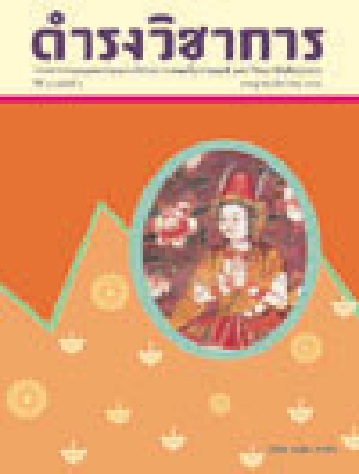A STUDY OF SPACING IN THAI WRITTING BY THAI AND JAPANESE STUDENTS
Keywords:
ภาวะภาษาในระหว่าง, การเว้นวรรคในการเขียนภาษาไทยAbstract
This research paper explores the inter-language study of spacing in Thai writing by Thai and Japanese students. Two sample groups were selected, based on the main criteria of Thai versus Japanese ethnicity and Thai as a native language. Thirty native speaking Thai students were selected from third-year and fourth-year classes in the Faculty of Arts, Chulalongkorn University and twenty non-native speaking students who had studied Thai in a Thai language school in Bangkok were selected and were further classified into 2 groups of high and low exposure to the Thai language. Eleven Japanese students were classified as high exposure while the remaining nine students were classified as low exposure. The research implementation consisted of a test using 66 specific positions for spacing determined by the Royal Institute (2008). The findings indicated that Thai students had higher proficiency in terms of spacing than the Japanese students. Within the two Japanese groups, the students from the high exposure group had a greater level of proficiency in terms of spacing which was closer to that of Thai native speakers than did Japanese students in the low group. The Thai students performed better in terms of spacing at the specific word level, which is subsumed under the specific rules of space. This implies that native Thai students more effectively used a number of spacing rules, different from Japanese students in both the high and low groups that scored lowest. It can be assumed that there is no spacing at word level in Japanese. Negative L1 transfer therefore comes into play and reveals that spacing at the word level seems problematic for Japanese students. As a result, it is advisable that Thai language instructors focus more on teaching word-level spacing for Japanese students in order to develop their Thai writing skills. Interestingly enough, native Thai students had the lowest level of proficiency on spacing at the phrase level, regarded as one of the optional rules leading to high variations of usage. In addition, Japanese students performed best in sentence-level spacing due to the positive L1 transfer. Spacing in other levels, however, is still problematic for Japanese students since there are no spacing rules in the Japanese language. In other words, negative L1 transfer still exists in spacing. Nevertheless, proficiency in using space in Thai writing can be developed. It is therefore a must for Thai language instructors to teach and provide Thai writing practice to consolidate students spacing skills at any level.
References
กอบกุล ถาวรานนท์. การเว้นวรรคในการเขียนหนังสือไทย. วิทยานิพนธ์มหาบัณฑิต ภาควิชาภาษาไทย คณะอักษรศาสตร์ จุฬาลงกรณ์มหาวิทยาลัย, 2521.
กําาชัย ทองหล่อ. หลักภาษาไทย. กรุงเทพมหานคร: โรงพิมพ์บําารุงสาส์น, 2525.
ผะอบ โปษกฤษณะ. ลักษณะเฉพาะของภาษาไทย. กรุงเทพมหานคร: โรงพิมพ์บําารุงสาส์น, 2538.
ราชบัณฑิตยสถาน. หลักเกณฑ์การใช้เครื่องหมายวรรคตอนและเครื่องหมายอื่นๆ หลักเกณฑ์การเว้นวรรค หลักเกณฑ์การเขียนคําาย่อ ฉบับราชบัณฑิตยสถาน. พิมพ์ครั้งที่ 6. กรุงเทพฯ: ราชบัณฑิตยสถาน, 2551. 56-66
อมรทิพย์ กวินปณิธาน. การศึกษาบริบทบ่งบอกชื่อเฉพาะในภาษาไทยตามแนวภาษาศาสตร์คอมพิวเตอร์. วิทยานิพนธ์ปริญญามหาบัณฑิต, ภาควิชาภาษาศาสตร์ คณะอักษรศาสตร์ จุฬาลงกรณ์มหาวิทยาลัย. 2546.
Briere, Eugene. John. A Psycholinguistics Study of Phonological Interference. Paris: C.H. Van schooneveled Indiana university, The Netherland by Mounton and Co., The Hague, 1968. 102
Corder, S.P. Introducuing Applied Linguistics. Middlesex: Penguin, 1973.
Gombert, Jean E. Metalinguistic Development. The University of Chicago Press, 1992.
Isarankura, S. Acquisition of the English Article System by Thai Learners: An Analysis of Metalinguistic Knowledge in English Article Use, Ph.D. Dissertation, Chulalongkorn University, 2008.
Luksaneeyanawin, S. A research report on characteristics and functions of pause in Thai. Linguistic Research Unit, Faculty of Arts, Chulalongkorn University. (in Thai), 1988.
Luksaneeyanawin, S. Unfolding Linguistics. In Wirote Aroonmanakun (ed.) Unfolding Linguistics. Bangkok: Chulalongkorn University Printing, 2007.
Selinker, L. Interlanguage. International Review of Applied Linguistics in Language Teaching, 10/3, 1972. 209-231
Downloads
Issue
Section
License
บทความนี้เป็นผลงานของข้าพเจ้าแต่เพียงผู้เดียว และ/หรือเป็นผลงานของข้าพเจ้าและผู้ร่วมงาน ตามชื่อที่ระบุในบทความจริง และเป็นผลงานที่มิได้ถูกนำเสนอหรือตีพิมพ์ที่ใดมาก่อน





